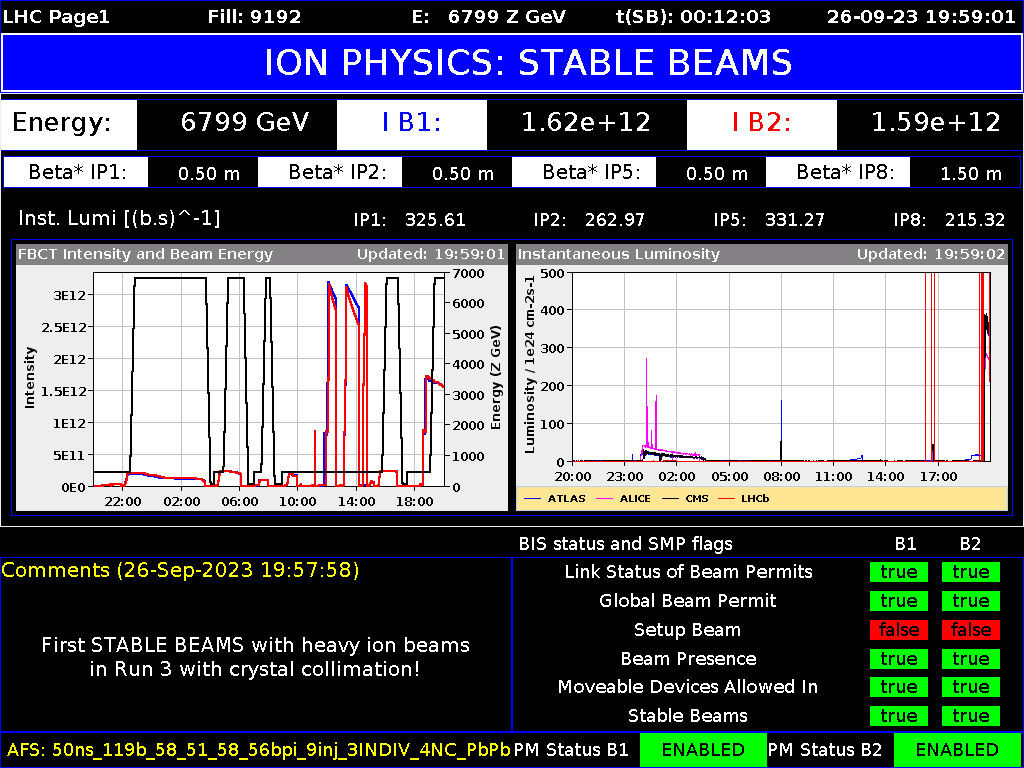The LHC is back delivering collisions to the experiments after the successful leak repair in August. But instead of protons, it is now the turn of lead ion beams to collide, marking the first heavy-ion run in 5 years. Compared to previous runs, the lead nuclei will be colliding with an increased energy of 5.36 TeV per nucleon pair (compared to 5.02 TeV previously) and the collision rate has increased by a factor of 10. The primary physics goal of this run is the study of the elusive state of matter known as quark-gluon plasma, that is believed to have filled the Universe up to a millionth of a second after the Big Bang and can be recreated in the laboratory in heavy-ion collisions.
Quark-gluon plasma is a state of matter made of free quarks (particles that make up hadrons such as the proton and the neutron) and gluons (carriers of the strong interaction, which hold the quarks together inside the hadrons). In all but the most extreme conditions, quarks cannot exist individually and are bound inside hadrons. In heavy-ion collisions however, hundreds of protons and neutrons collide, forming a system with such density and temperature that the colliding nuclei melt together, and a tiny fireball of quark-gluon plasma forms, the hottest substance known to exist. Inside this fireball quarks and gluons can move around freely for a split-second, until the plasma expands and cools down, turning back into hadrons.
The ongoing heavy-ion run is expected to bring significant advances in our understanding of quark-gluon plasma. In addition to the improved parameters of the lead-ion beams, significant upgrades have been performed in the experiments that detect and analyse the collisions. ALICE, the experiment which primarily focuses on studies of quark-gluon plasma, is now using an entirely new mode of data processing storing all collisions without selection, resulting in up to 100 times more collisions being recorded per second. In addition, its track reconstruction efficiency and precision have increased due to the installation of new subsystems and upgrades of existing ones. CMS and ATLAS have also upgraded their data acquisition, reconstruction and selection infrastructure to take advantage of the increased collision rates. ATLAS has installed improved Zero Degree Calorimeters, which are critical in event selection and provide new measurement capabilities. LHCb, in addition to performing studies of lead-lead collisions with an upgraded tracking system, is preparing a unique programme of fixed-target collisions of lead nuclei with other types of nuclei using its unique SMOG2 apparatus that allows various gases to be injected into the LHC collision area.
Studies of quark-gluon plasma in this heavy-ion will focus on rare processes such as the production of heavy quarks, quarkonium states, real and virtual photons and heavy nuclear states. The increased number of collisions is expected to allow measurement of the temperature of the plasma using thermal radiation in the form of photons and electron-positron pairs. Hydrodynamic properties of the near-perfect liquid state of matter will be measured in greater detail and “tomography” using particles such as the charm or beauty quarks that are produced in the initial phase of the collision, pass through the plasma and are detected afterwards. All these measurements will be far more precise than before.
In addition to studies of quark-gluon plasma, the experiments will be looking at so-called ultra-peripheral collisions of heavy ions, in which the beams do not collide directly, but one beam emits a high-energy photon that strikes the other beam. These collisions will be used to probe gluonic matter inside nuclei and to study rare phenomena such as light-by-light scattering and τ lepton photoproduction.
Five years after the previous heavy-ion run, expectations are high.

 Event display showing a lead-lead collision in the ATLAS detector. (Image: ATLAS)
Event display showing a lead-lead collision in the ATLAS detector. (Image: ATLAS)



